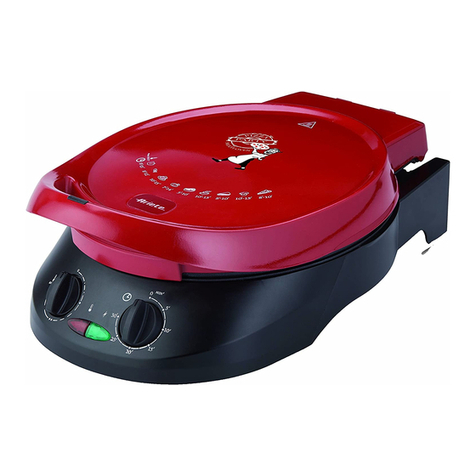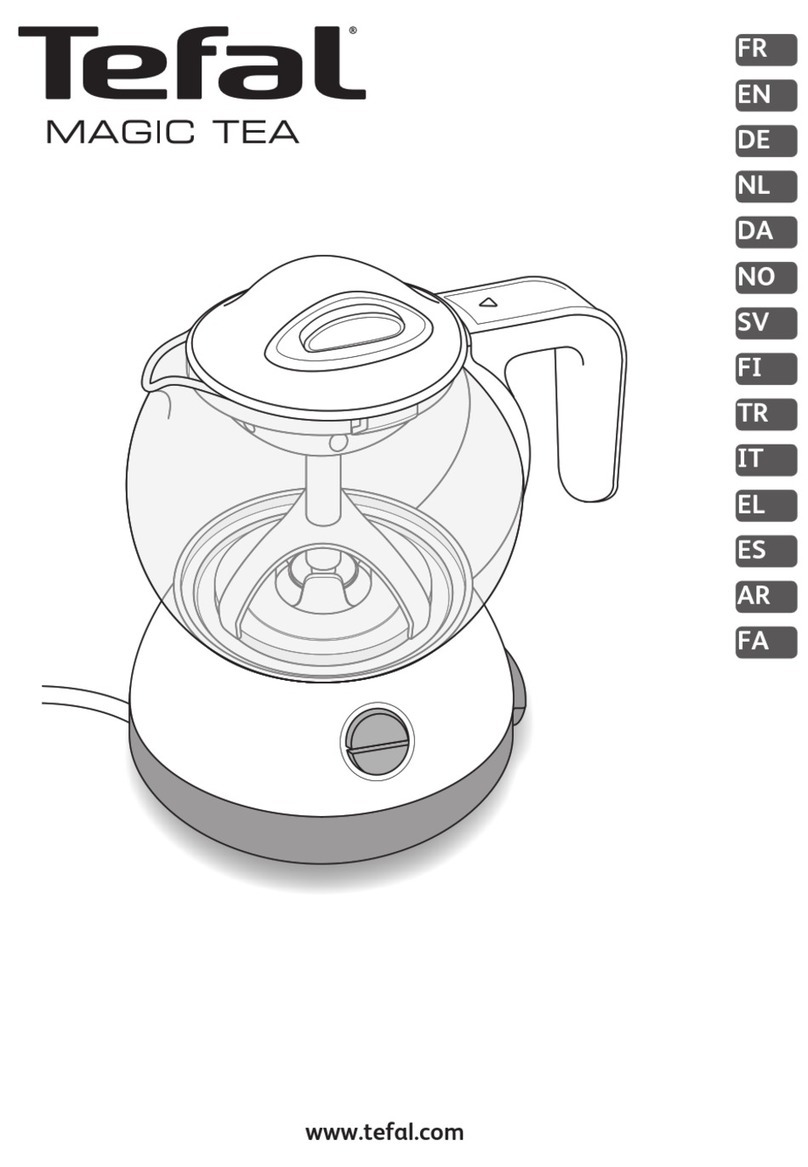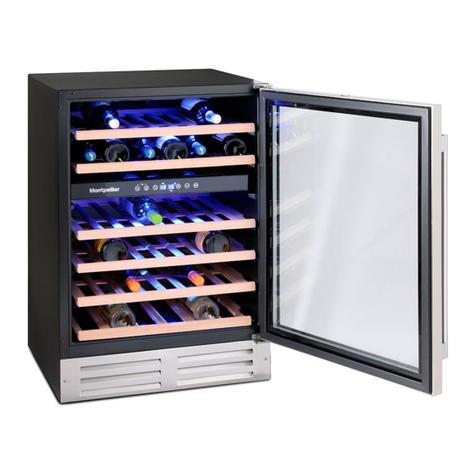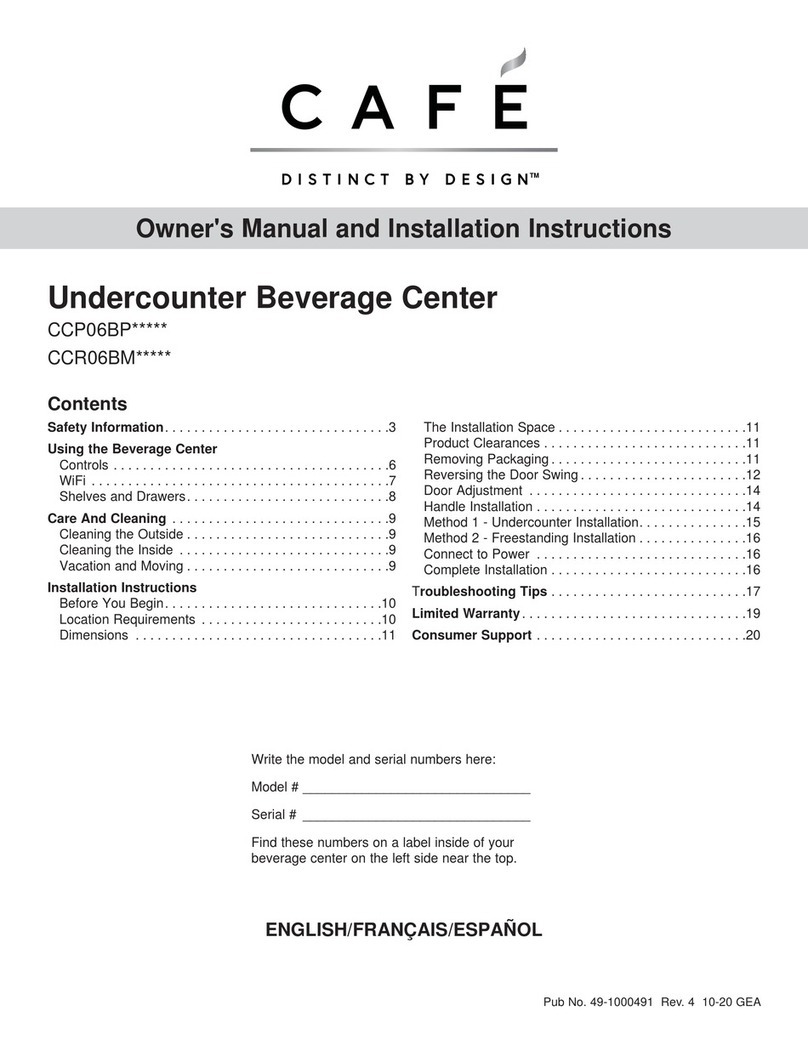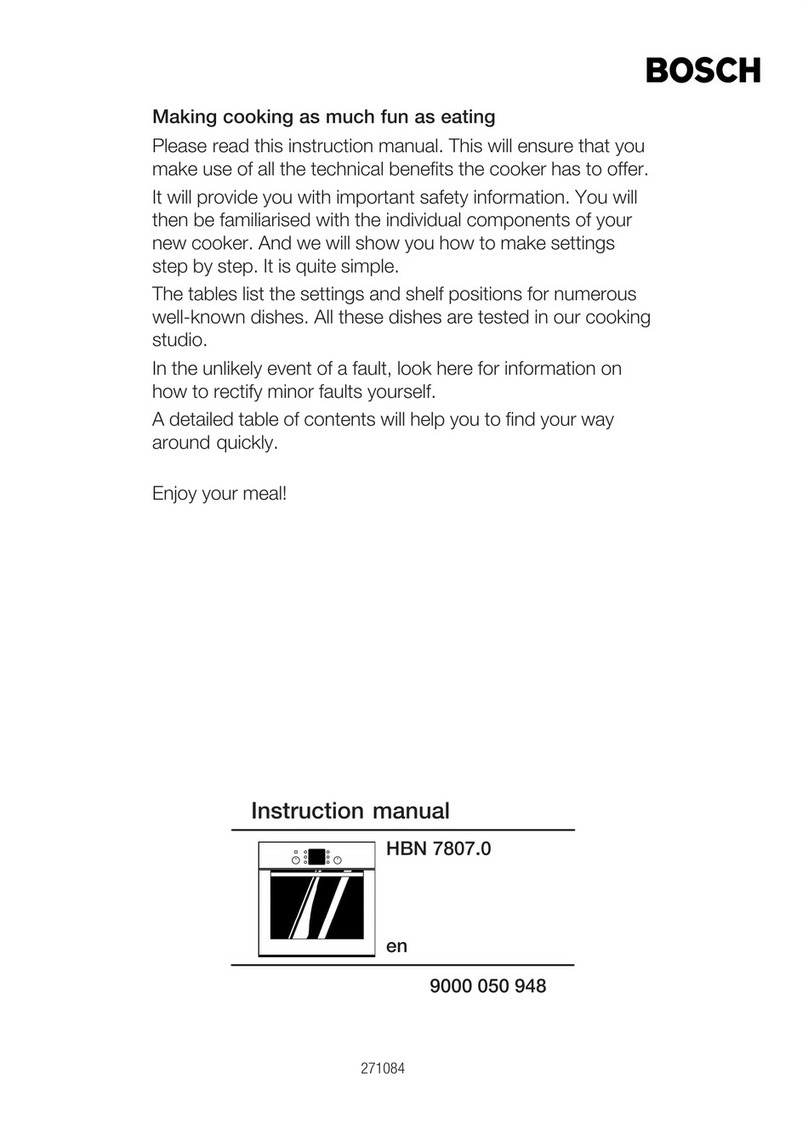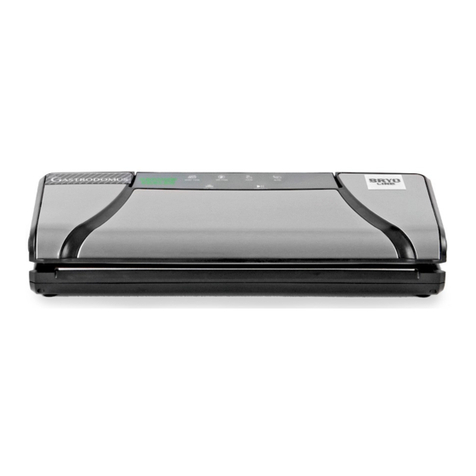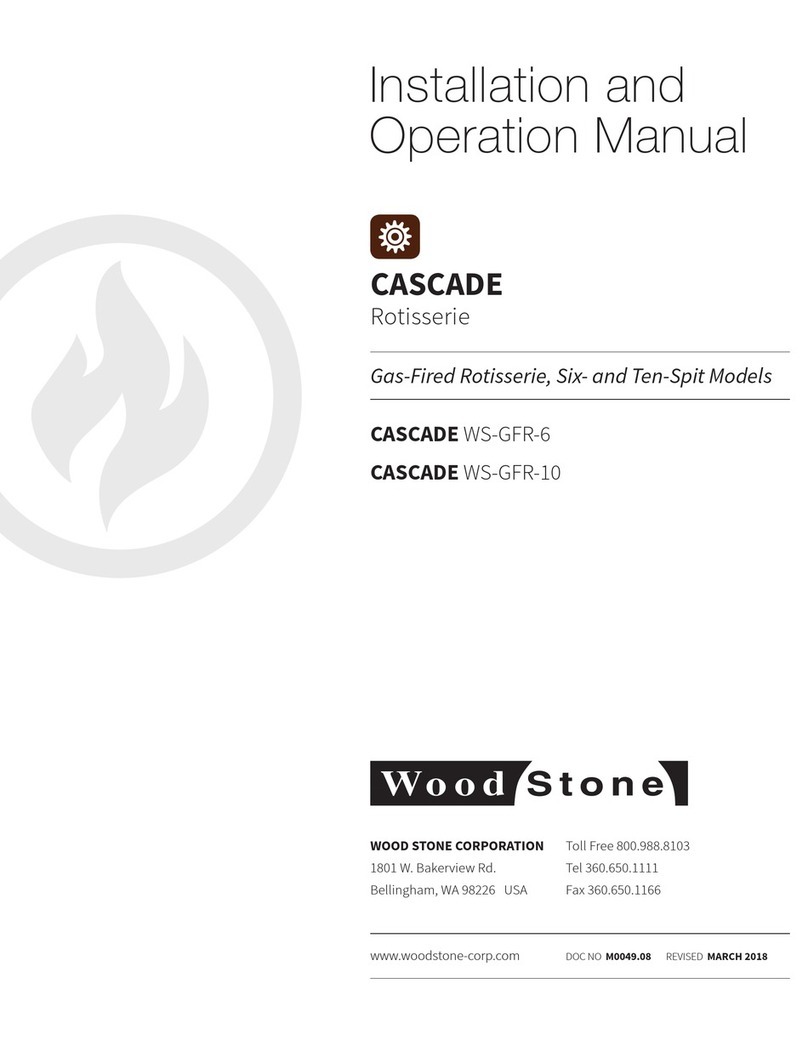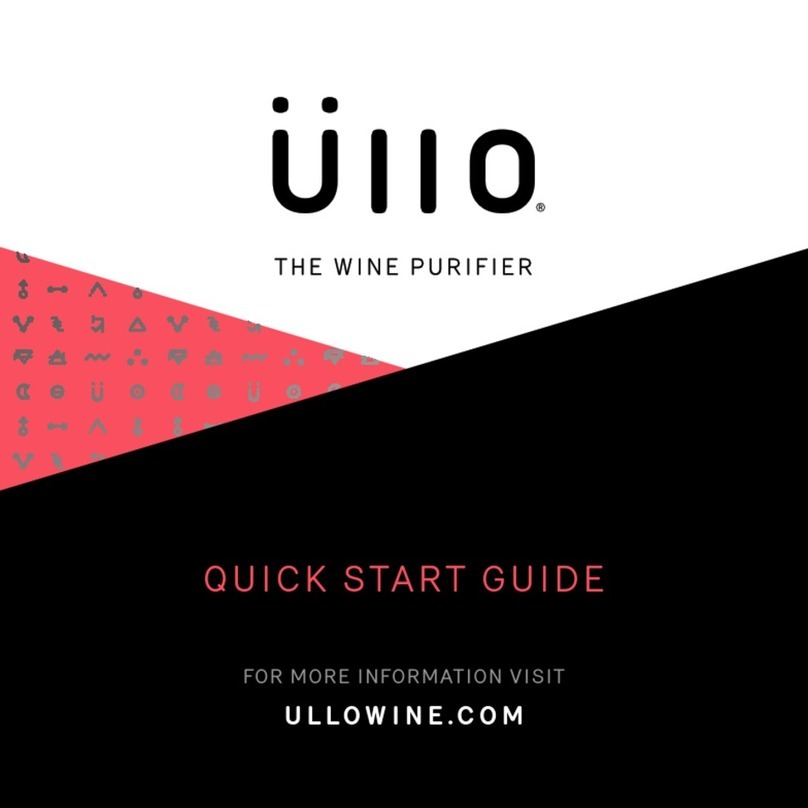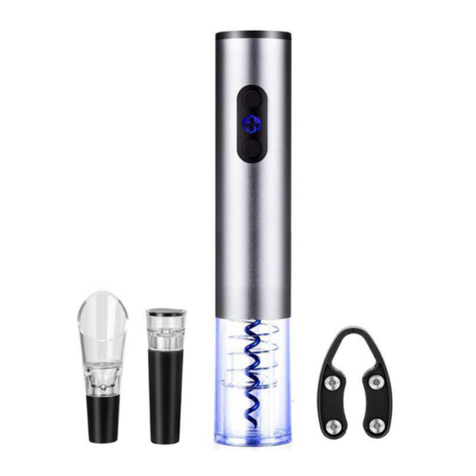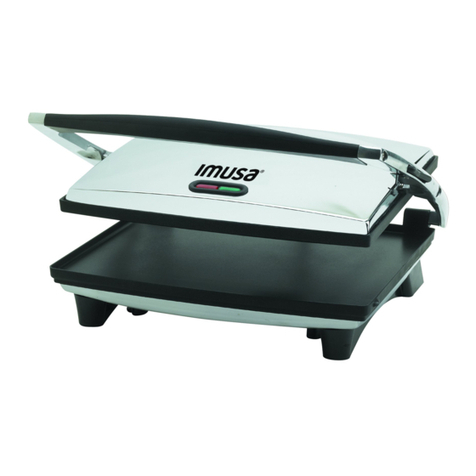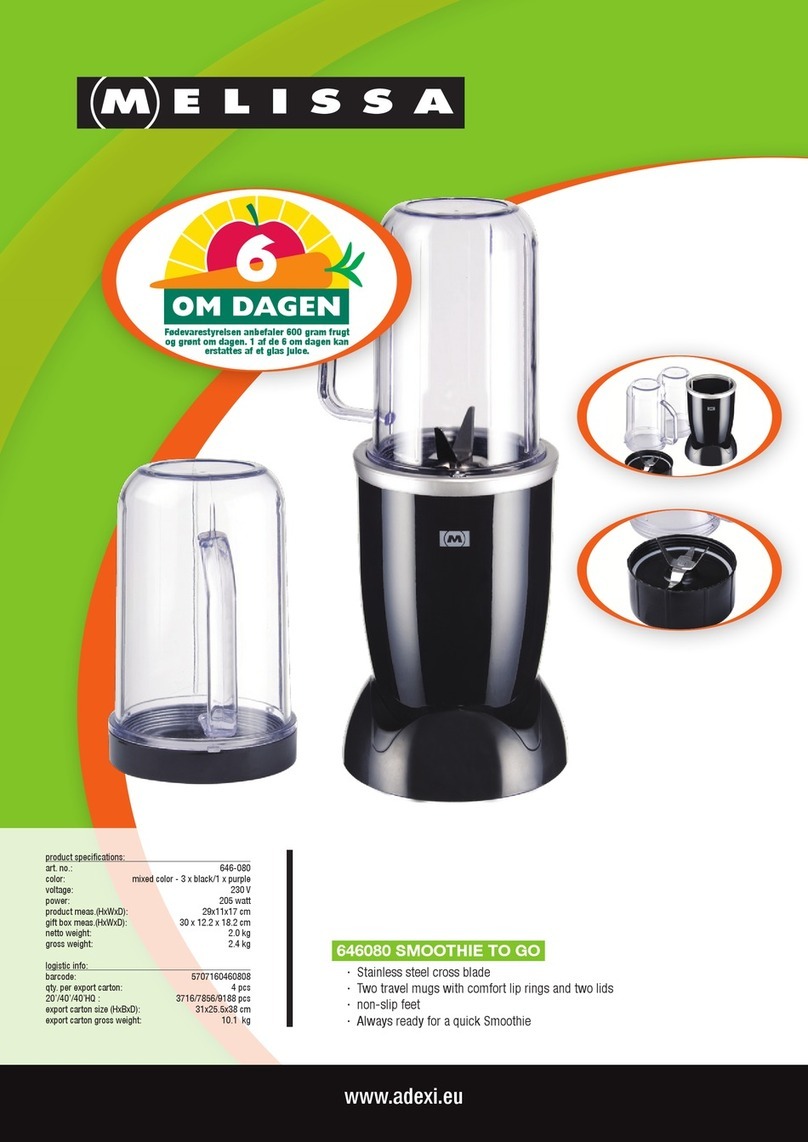KAFFELOGIC Nano 7 User manual

INSTRUCTIONS FOR USE
™
Model KN1007B

1
KAFFELOGIC - Nano 7.0
KAFFELOGIC Nano 7
benchtop coffee roaster
(Model KN1007B – firmware version 7.4 or higher)
Thank you for joining the Kaffelogic revolution.
Have fun and enjoy fantastic coffee.
This appliance is suitable for professional
use and is also intended to be used in
household and similar applications (such as
staff kitchens in workplaces, farm houses,
and for client use within the hospitality
industry), provided that either (i) the user
can manage the flow of smoke so that
smoke detector alarms are not activated, or
(ii) the user can safely temporarily disable
smoke detector alarms in the vicinity
of the appliance in accordance with the
smoke detector manufacturer’s or building
owner’s instructions. This appliance is
not suitable for use in a building within
range of smoke detectors that are directly
connected to a sprinkler system or to the
fire service.
The symbol means “Caution: hot surfaces.”
SAFETY
This appliance complies with AS/NZS 60335.2.9.
This is an electrical appliance that contains sophisticated electronics. Like other
cooking appliances, such as a toaster, if something goes wrong it could start a fire.
1. Read all safety instructions before use.
2. For indoor use only.
3. Use upright on a solid level surface.
4. Do not overload.
5. Use only for roasting green coffee
beans. Although it contains many safety
features, other substances – such as
popcorn or nuts – could mislead the
safety checks and may result in fire or
damage to the appliance.
6. If you operate the appliance on an
induction cook top the appliance feet
must have a minimum separation of
20mm above the cook top surface.
This avoids accidental activation of the
cook top by preventing it detecting the
appliance as a pan. Place the appliance
on a breadboard or purpose-made riser
with a minimum thickness of 20mm.
7. Use only with adequate ventilation,
preferably close to a kitchen extractor fan.
8. Use at least 100mm away from walls
and 150mm away from curtains
measured horizontally.
9. Make sure that nothing blocks the air
inlet (under the base) or outlet (at
the top) when the appliance is in use.
Slowing the air down will cause it to
heat faster. It will ruin a batch of coffee
if the safety systems shut it down
mid-roast, and if the air is completely
blocked it could damage the appliance
or start a fire.
10. Be sure to fit the chaff collector the
correct way up. Please refer to the
illustrations in the section ‘Parts of
the Roaster’.
11. Keep the area around the appliance
free of spilled chaff and other loose
material that could be sucked into the
roaster during operation.
12. The appliance is fully automatic, but
you should remain in the vicinity while
in use. Do the dishes, clean your teeth,
but don’t go out to a movie.
13. This appliance is not intended to be
operated by means of an external timer
or separate remote control system.
INSTRUCTIONS FOR USE
™

2 3
KAFFELOGIC - Nano 7.0 KAFFELOGIC - Nano 7.0
Safety continued ...
14. May trigger a smoke alarm during normal
operation. Ensure that you follow the
smoke alarm manufacturer’s instructions
if you need to temporarily disable a
smoke alarm during the operation
of the coffee roaster. Do not use this
appliance in a commercial building where
smoke detectors may trigger a building
evacuation or fire service call out.
15. The chaff collector becomes too hot
to touch during roasting. Wait until the
cool down part of the roasting cycle has
finished before removing the chaff collector.
16. Do not immerse in liquid. Use a damp
cloth to wipe it down if required. Water
will damage the electronics. For more
information on cleaning, see the section
on ‘Cleaning’ (page 11).
17. If liquid enters the roast chamber
or any other part of the appliance,
unplug the power supply and allow
24 hours in a warm place for the
interior of the appliance to dry
completely before attempting to
use the appliance again.
18. If damaged, the supply cord
must be replaced by a qualified
technician.
19. Do not open the case unless it
is unplugged from the power
supply. There are live wires in the
appliance, so there is a risk of
electrical shock.
20. Contact the manufacturer if you
see persistent error messages on
the display.
This appliance is not intended for use by persons (including children) with reduced
physical, sensory or mental capabilities, or lack of experience and knowledge,
unless they have been given supervision or instruction concerning the use of the
appliance by a person responsible for their safety.
Children should be supervised to ensure that they do not play with the appliance.
Check online at kaffelogic.com/support for the latest version of these instructions.
LID
MESH
CHIMNEY
DISPLAY
CONTROLS
CHAFF
COLLECTOR
BASE
PARTS OF THE ROASTER

4 5
KAFFELOGIC - Nano 7.0 KAFFELOGIC - Nano 7.0
FIRST USE
1. Remove all packaging including the interior
packaging around the chimney inside the chaff
collector.
2. Please read ‘The basics’ section below, and
familiarise yourself with the ‘Safety’ section
above.
3. At first the chimney will sit quite loosely into
the chaff collector, but this will tighten up over
the first few roasts.
1. SCOOP – use a level
scoop of green beans.
[ Use the provided scoop.
Otherwise measure 120–160mℓ
or 90–120g. Do not overℓoad.
If you are using monsooned
or decaf beans they are ℓess
dense and it is recommended
that you ℓoad by weight ].
2.1.
THE BASICS
2. LOAD – take the chaff
collector off and pour
green beans straight into
the roasting chamber.
3. CLICK – put the chaff
collector back on, select
roast level (See ‘Levels’
and ‘Display Controls’
section page 8-9) and
click thebutton to
begin roasting.
(Ensure chaff coℓℓector ℓid is
in pℓace as shown above).
3.

6 7
KAFFELOGIC - Nano 7.0 KAFFELOGIC - Nano 7.0
THE SMOKE
The smoke from roasting is no more
than from cooking many other foods.
However, it does have a strong smell and
you should use an air purifier, extractor
fan or range hood if possible. For best
results place the appliance directly under
a range hood. Be aware of where the
nearest smoke detector is and be ready
in case it is activated by the smoke.
THE ROAST
A normal roast will take around 8 to 12
minutes, getting steadily hotter until it
reaches between 220 and 240 degrees.
Cool down will then start and this will
take anything from 4 to 5 minutes. The
roaster will automatically stop once cool
down has finished.
EMPTYING THE CHAFF
Allow several minutes for the aluminium
chimney to cool fully. When it has cooled,
take the lid off the chaff collector, remove
the aluminium chimney, and empty the
chaff into the compost.
You may find you can do several roasts
before you need to empty the chaff
collector, but don’t let it fill beyond halfway
up the mesh. After emptying make sure
the aluminium chimney is replaced and
fully seated in the plastic part.
THE FINALÉ
When the roaster has stopped, take off
the chaff collector. The lower part of the
chaff collector should be cool enough to
handle straight away. Pick up the whole
roaster with both hands. Tip the roasted
beans into a bowl, jar or bag. You can
leave the beans in the roaster for some
time before emptying— it’s ok to roast at
night, leave the beans in the roaster, and
bag up the next day.
Empty coffee beans Remove aluminium chimney Empty chaff collector
TOP BOTTOM CHAFF COLLECTOR
CHAFF COLLECTOR
Make sure the chaff collector is the
right way up, the lid is in place and the
aluminium chimney is fully seated inside
it (see illustrations below). Operating this
appliance with the chaff collector upside-
down will result in chaff getting into the
roasted beans, and spilling on the bench.

8 9
KAFFELOGIC - Nano 7.0 KAFFELOGIC - Nano 7.0
LEVELS
Adjust the roast level before you start the roast – use the lighter/darker buttons.
Kaffelogic Nano US roast name Stage Description
Very light 0.1—0.9 New England Beginning of first crack Dry bean surface,
mottled and uneven in
colour
Light 1.0—1.9 American First crack is under way
Med-light 2.0—2.9 City End of first crack Dry bean surface, even
colour.
Medium 3.0—3.9 Full City Beginning of second crack Tiny droplets or faint
sheen of oil
Med-dark 4.0—4.9 Espresso Second crack is under way Shiny bean surface
Dark 5.0—5.9 Italian End of second crack Very shiny bean surface
DISPLAY AND CONTROLS
When scrolling through the display
options select ‘live data’. You will see
heater power, fan speed, and rate of
rise displayed in real time, as shown
above.
Profile Name
Time: min:sec Roast Level Temp (°C)
9:00 L3.5 * 205.7
K-logic classic
Heating Power
(Watts)
Fan Speed
(RPM)
Rate of rise
(°C per min)
9:00 L3.5 * 205.7
1150 w 15000 32.8
Press the ‘menu’ button repeatedly
to scroll through the various display
options. Press the ‘profile’ button
to return to the standard display
shown above.
MenuProfileStartLighter Darker
Stage: * = roasting
= cooling
STANDARD DISPLAY LIVE DATA DISPLAY

10 11
KAFFELOGIC - Nano 7.0 KAFFELOGIC - Nano 7.0
TESTING
The correct way to test the roaster is to
start it with no beans. It will heat up for
10 to 20 seconds, reaching about
90 degrees.
Then a message will flash up: “Heat
too fast. Please check beans.” At this
point the machine doesn’t stop, but it
begins the cool down cycle and runs
for another 10 to 20 seconds until it has
cooled down to about 40 degrees. At
this point it stops.
Running this test is a good way to be
confident that everything is working as
expected.
This test will also generate a log file so it
can be used to check you have set things
up correctly for collecting roast logs.
RESTING THE COFFEE
Coffee changes flavour very rapidly
during the first week after roasting, and
the most rapid changes take place in the
first few days. Waiting before using the
coffee is known as ‘resting’ the coffee.
The purpose of resting is to let the
flavour improve.
The Kaffelogic core profiles provided on
the Kaffelogic memory stick include Ready
to Drink (RTD) profiles designed to need
no resting, and Rest profiles designed to
need 3 to 5 days resting.
For other profiles the ideal amount of
resting might vary. Try the coffee over a
period of days. As Matt Perger, founder
of Barista Hustle, says: “use it when it
tastes good”.
CLEANING
Brush off any loose chaff. Wipe the
outside of the roaster with a damp
non-abrasive cloth and polish with a
dry lint-free cloth or paper towel. Use
a little bit of soap, detergent, or other
non-abrasive cleaner on the damp
cloth if required. Unplug from the wall
when using a damp cloth.
There will be a build-up of coffee oils
in the roast chamber over time. We
recommend that you do not clean the
roast chamber so long as there is no
noticeable effect on the flavour of the
roasted coffee. When you need to clean
the build-up of coffee oils, remove the
chaff collector and wipe inside with a
cloth dampened with a suitable cleaner
such as
Puly™ Caff detergent, Cafetto™
Espresso Clean, Simple Green™ or other
non-caustic, non-abrasive cleaner
.
Move the cloth around with your finger or
a chopstick.
IMPORTANT:
You need to be particularly
careful not to touch the sensitive tip of
the temperature probe that sticks into
the roast chamber part way down. Do not
clean the tip of the probe.
Do not use detergent inside the roast
chamber or you will end up with
detergent flavoured coffee.
Temperature Probe

12 13
KAFFELOGIC - Nano 7.0 KAFFELOGIC - Nano 7.0
ROAST PROFILES
A roast profile is a curve that tells the
roaster the exact temperature required
at each time during the roast. The shape
of a roast profile curve is critical for
determining the development of flavour
during roasting.
Kaffelogic roast profiles do not specify
when to end the roast. The end of the
roast is controlled by the roast level: a
number from 0.1 to 5.9 that is set by the
user. A single profile curve can be used to
obtain a range of roast styles simply by
varying the level.
The roast levels are described in the
‘Levels’ section above. Normally you will
want to adjust the level for a particular
coffee origin until you achieve exactly the
results you are after. Trial and error is an
effective method. We recommend you
start at between 3.0 and 3.6 when aiming
for a medium roast.
Although the default profile is a Jack-
of-all-trades that will produce fantastic
coffee, you can further improve results
by choosing a profile that has been
developed specifically to suit the style of
beans or your desired style of roast.
For help selecting a profile see Kaffeℓogic
Roaster’s Companion available from
kaffelogic.com/support.
To load a new roast profile:
1. Plug the supplied memory stick into
your Kaffelogic Nano 7.
2. Click Profiℓe. Keep clicking Profiℓe until
the profile you want shows up on the
display.
3. Clickto load the profile. The profile will
load and the level will also change to the
recommended level for that profile.
4. You are now free to alter the level to
suit your tastes and to start roasting
with that profile.
5. The memory stick can be removed
from the roaster (but you will want to
keep it there if you are collecting log
files for your roasting).
Additional profiles can be downloaded
from kaffelogic.com/community. Download
the profile, open it with Kaffelogic Studio
(available from kaffelogic.com/support)
and click save to USB.
ROAST LOGS
A roast log will be saved if there is
a memory stick plugged into the
roaster during a roast. Roast logs are
automatically saved in the folder called
/kaffelogic/roast-logs/. Put the memory
stick in your computer to view the log.
Open the log file with Kaffeℓogic Studio
(available from kaffelogic.com/support ).
Write the name of the beans and your
tasting notes in the tasting notes section
under the About this fiℓe tab.
The roaster does not date the log
files; instead it gives them sequential
numbers. This makes it easy to keep the
files in order, but if you need to record
the actual roast date you must include it
in the tasting notes.
You can verify that logs are being
generated by running a test roast (see
the ‘Testing’ section above).
The roaster should create the folder
/kaffelogic/roast-logs/, however if
something goes wrong you can create
the folder yourself on your computer
and then verify that logs are being
generated (see ‘Testing’ above). Note that
the Nano 7 supports the FAT/FAT32 file
system only. The Nano 7 does not support
the exFAT file system.
A roast log will be saved if there is a memory
stick plugged into the roaster during a roast.
USB Stick

14 15
KAFFELOGIC - Nano 7.0 KAFFELOGIC - Nano 7.0
TIMER MODE
The roaster has a timer mode so that you
can use it as a brew timer. Put the roaster
into timer mode by pressing both Profiℓe
and Menu buttons together.
Press Profiℓe & Menu buttons together
again to go back to automatic roasting
mode.
In timer mode the button starts and
stops the timer, but it does not control the
heat or the fan. The lighter/darker buttons
are used to manually control the heat and
fan, which can be useful when developing
profiles: for example, you can observe
how the beans fluidize by running the
fan without any heat. You can even do an
entire roast manually; so long as the timer
is running and the heat is on, a log file will
be recorded.
Memory stick file structure
The ‘kaffelogic’ folder contains 3 sub-
folders: ‘roast-logs’, ‘roast-profiles’, and
‘firmware’. If you are creating these
folders yourself take care to ensure
the spelling is correct and there are no
capital letters.
RESET
Occasionally the memory where the
profile details are stored can become
corrupt, for example a power failure
during a roast could cause this.
This can cause unusual characters
to appear on the display and the
roaster may become unresponsive. To
reset the roaster and restore factory
defaults, hold down the button while
you turn the roaster on. If you do this,
you will have to load your profile and
set your chosen level again.
UPDATES
Updates can be downloaded to a
memory stick using Kaffeℓogic Studio or
from kaffelogic.com/support. Updates
are saved in a folder called ‘firmware’, a
sub folder of the ‘kaffelogic’ folder on
the memory stick. Then put the memory
stick in the roaster and reset it (i.e. hold
down thebutton while you turn the
roaster on). The firmware update will
install automatically and the level and
profile will return to default values. You
will have to load your profile and set
your chosen level again.
IN THE UNLIKELY EVENT OF AN EMERGENCY:
You can stop the roast early by pressing then - while it is roasting. Stopping the
roast early puts the machine straight into cool down. (Turning the machine off will
also stop the roast – it will automatically enter cool down if you turn it back on again
straight away.)
1. Check that the roast chamber is empty
before you add green beans. Hold the
roaster upside down and gently shake
to dislodge any beans that get stuck.
If you need to reach inside the roast
chamber to dislodge a bean be careful
not to touch the thermocouple probe
because it is fragile.
2. If chaff falls into the roast chamber
it is important that you remove it
immediately before it has a chance
to work its way inside the appliance
where it may create a fire risk. If
there are just a few bits of chaff
in the chamber, blow gently into
the chamber to remove them.
Alternatively, put the roaster into
timer mode: press Profiℓe and Menu
buttons together. Then turn on the fan
using the + button. Press Profiℓe and
Menu buttons again to stop the fan
and return to automatic mode.
3. If you spill chaff on the bench you
should clean it up before operating
the roaster. This is to prevent chaff
being drawn into the air intake slots in
the base of the roaster.
4. If a granular or powdery substance
such as rice or flour gets into the
roast chamber you should have a
service technician strip and clean
the appliance before you attempt
to use it again. This is because such
substances can fit between the fins
and get onto the element or fan
motor inside the appliance.
FURTHER INFORMATION ABOUT THE ROASTER

16 KAFFELOGIC - Nano 7.0
5. The temperature probe is unshielded.
This delivers accurate profile-following
performance, but it comes at the cost
of making the probe tip vulnerable
to damage. The tip will survive many
hundreds of roast cycles if you pour
the beans in and out of the chamber,
but if you reach into the chamber to
clean or dislodge stuck beans, then
you must take care not to touch the
probe tip. If you do damage the probe
tip the roaster will not operate. The
probe is considered to be a wearable
part and damage to it is not covered
by warranty. It is replaceable by a
service technician.
6. The roaster is designed for use
with typical supply voltages in New
Zealand and Australia between 230
and 240 Volts. While it is safe to
connect it to lower supply voltages
such as typically found in Europe (210
to 220V), there is not enough power
available below 220 Volts to always
guarantee a perfect roast. The roaster
will give a warning if the voltage is
marginal. This will happen occasionally
in residential areas where you are
some distance from the nearest
supply transformer and sometimes in
commercial buildings with long feed
lines from the main board. In most
cases it is ok to proceed with roasting,
but you should record a roast log
so that you can see if the roaster is
struggling to reach the temperature
required by the roast profile.
7. It is advisable to plug the roaster
directly into the power supply without
using an extension cord. Voltage can
drop in an extension cord after the
roaster has performed its voltage
check. If you are using an extension
cord, especially a long one, you
should record a roast log so that you
can see if the roaster is struggling to
reach the temperature required by the
roast profile.
8. If the roaster is interrupted during a
roast – say you accidentally turn off
the switch at the wall – then, when the
power comes back on it will start cool
down. Usually this means the beans
will be ruined unless you interrupted
the roast when the temperature was
below about 80 degrees or the roast
was nearly finished anyway.
SUPPORT
Visit the support pages at
kaffelogic.com/support
Ask questions, browse info, and
download profiles at
kaffelogic.com/community.
Contact us by email:
support@kaffelogic.com
Model Number: KN1007B
Power Consumption: 230-240V AC
50Hz 1300-1400W
Further information about the roaster continued ...

kaffelogic.com
This manual suits for next models
1
Table of contents
Popular Kitchen Appliance manuals by other brands
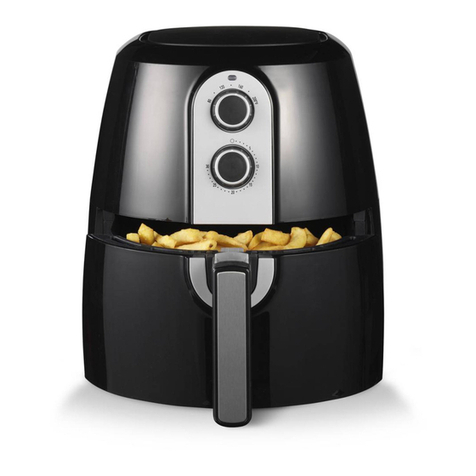
tomado
tomado Smart Fryer TM-1975 instruction manual
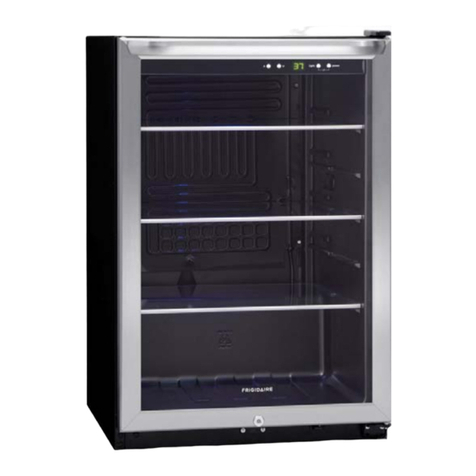
Frigidaire
Frigidaire CFBC46F5LS Features and specifications
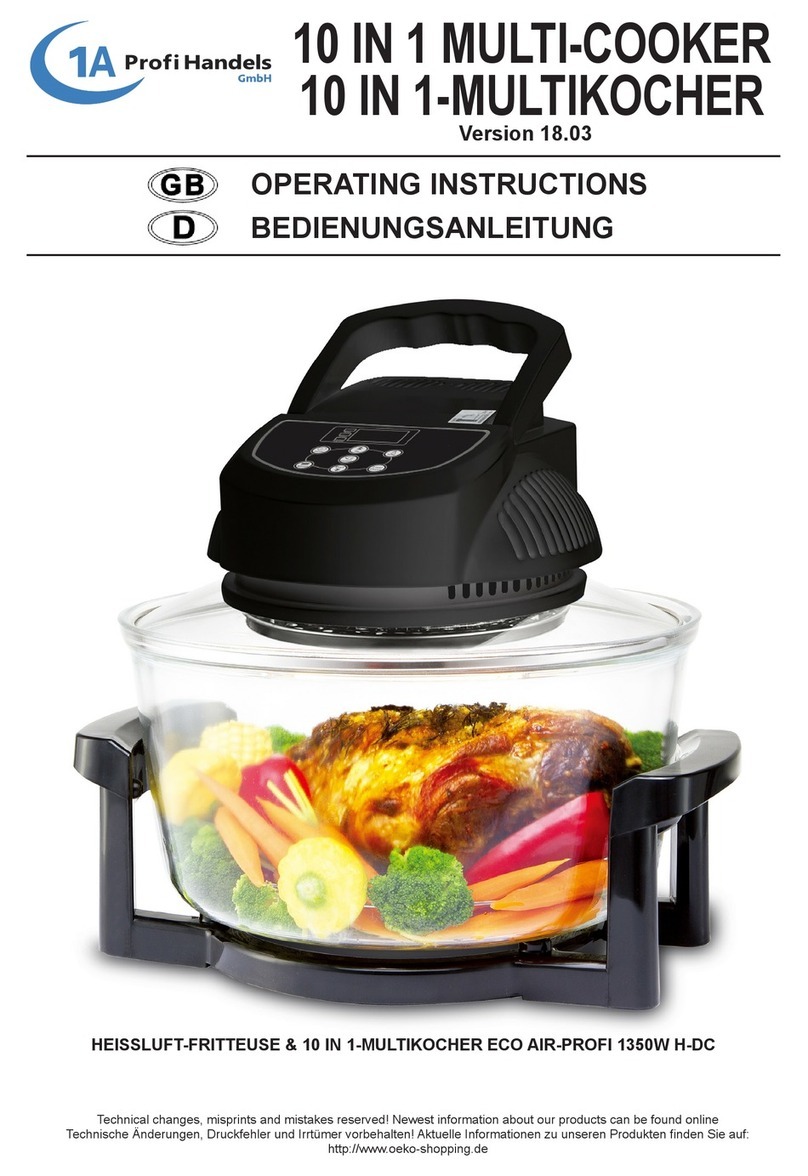
Profi Handels
Profi Handels 10 IN 1 MULTI-COOKER operating instructions

Master Culinary
Master Culinary X-1100 Owner's manual and cooking guide

Westfalia
Westfalia ELE012110 instruction manual
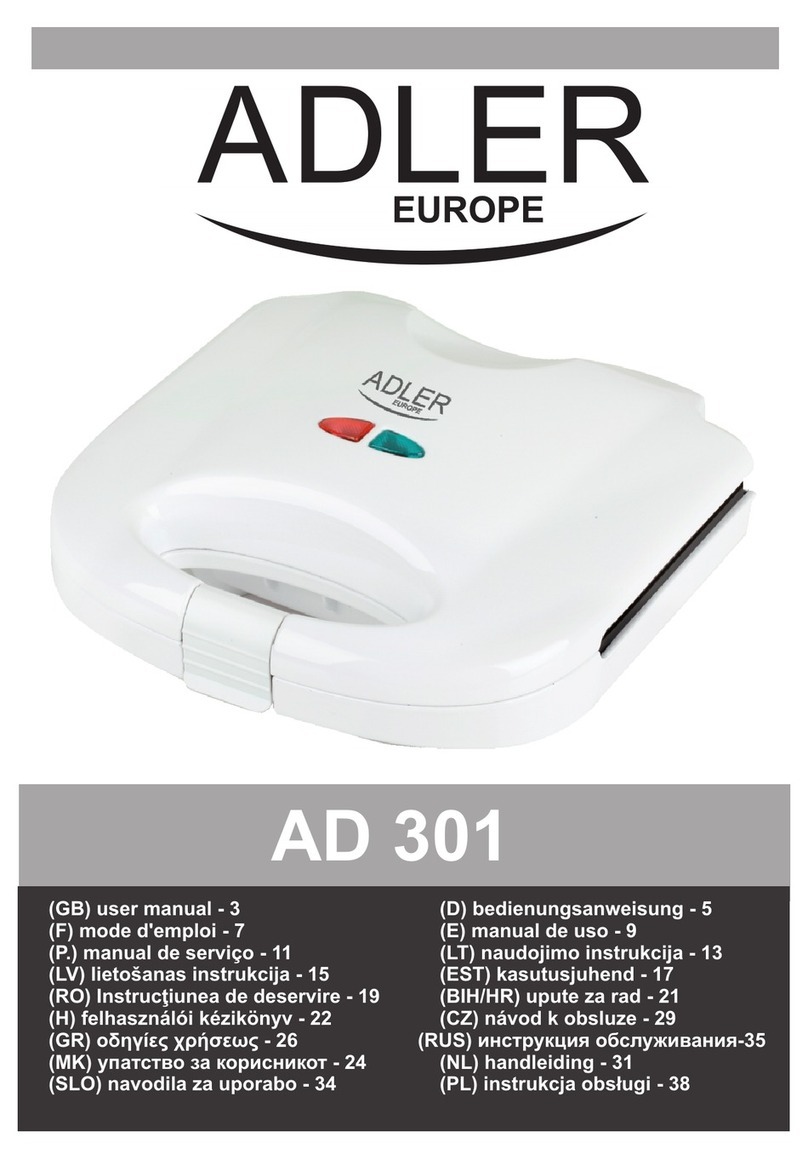
Adler Europe
Adler Europe AD 301 user manual
